An analytic chemist in your back pocket. A forensic laboratory in a suitcase. A HazMat team in the trunk of your car. First responders need all the help they can get when faced with potentially dangerous substances.
Mira DS from Metrohm Raman is a sophisticated chemical analyzer that replaces the specialist with automation.
The push of a button initiates proprietary Smart Acquire routines to optimize acquisition parameters and collect the highest quality spectra. These spectra are automatically subjected to library search and Mixture Matching routines capable of identifying up to three components of a mixture. When hazardous substances are detected, the user is alerted to immediate action with color-coded warnings.
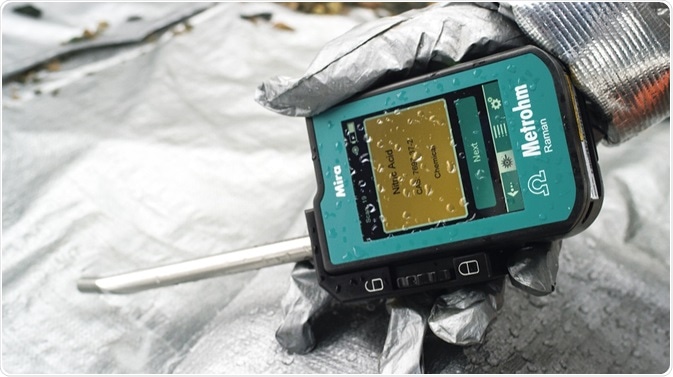
Introduction
Raman analysis is an established technique for identification of substances by field professionals. In the presence of a potentially deadly white powder, defense and security teams require safe, fast, and accurate identification to inform a proper response, for example:
- Confiscated Street Drugs
- Illicit Lab Residue
- Potential Explosives
Not everyone is an expert at Raman analysis: Metrohm Raman’s Mira DS combines automated acquisition with sophisticated analysis in a rugged handheld unit, putting instant actionable intelligence in the palm of your hand.
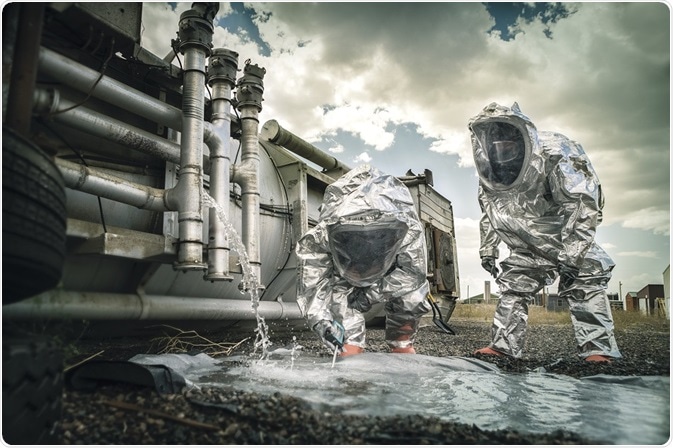
Raman Spectra
All substances have unique molecular properties that can be used to identify them, like a person’s unique fingerprint. For example, Figure 1 illustrates Raman spectra of TNT, RDX, and PETN: high explosives that are used to make Improvised Explosive Devices (IEDs).
The high spectral resolution and location of peaks permit each of these materials to be easily identified; spectral quality is an important factor in accurate identification.
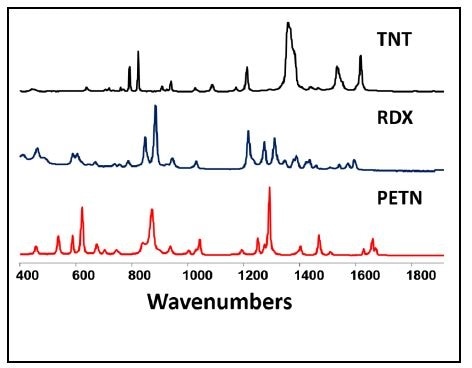
Figure 1. Raman Spectra of High Explosives
Smart Acquire
Field personnel using Raman instruments may not have the training or the response time to determine ideal acquisition parameters and collect quality spectra. Smart Acquire algorithms automatically optimize acquisition parameters at the press of a button. The full process is shown below in Figure 2.
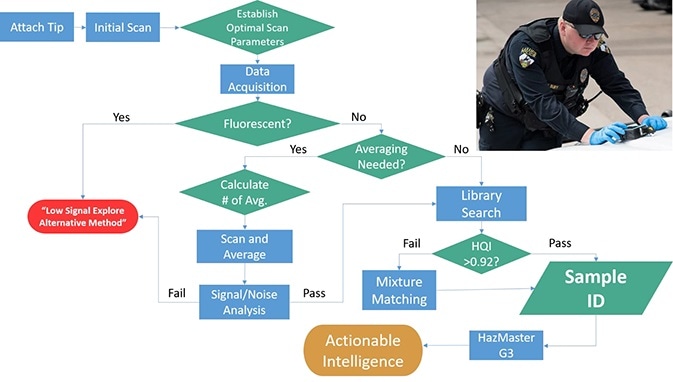
Figure 2. Smart Acquire Flowchart
Mixture Matching
Smart Acquire routines result in optimal data collection for any operator- this leads to accurate, reliable identification of substances. It also ensures that the highest quality spectra are submitted into Mixture Matching routines. Mixture Matching analyzes whether a spectrum could possibly represent a combination of substances.
First responders frequently encounter mixtures of chemicals: an explosive and its activator, drug "cocktails" made of narcotics mixed with cutting agents, and residual chemicals from production or refinement processes. Research into known combinations of illicit materials results in tagged and treed libraries that can deconvolute multiple spectra from complex mixtures
Cocaine in a Complex Mixture
Consider the following spectra: the blue curve in Figure 3 is real data collected from a street drug sample. A preliminary library search results in a positive match for sodium bicarbonate (Figure 3, green).
However, sodium bicarbonate is a well-known cutting agent for cocaine. This relationship is specified in treed libraries, which establish correlations between commonly associated substances. Detection of this suspicious chemical automatically activates Mixture Matching algorithms.
In less than a second, Mixture Matching confirms the second component as cocaine, the red spectrum in Figure 3. Note that Mira DS accurately identified cocaine, although it is clearly the minor component in the street sample.
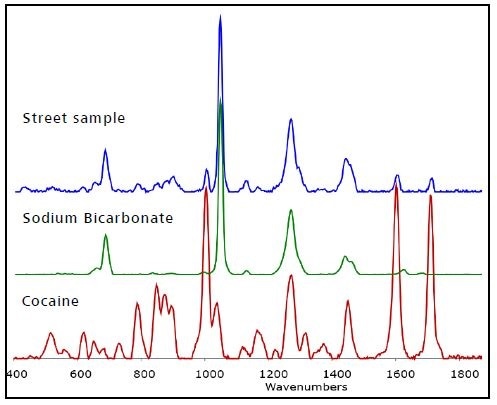
Figure 3. Identifying Cocaine in a Drug Cocktail
Informed Reporting
Upon successful identification of an illicit substance, tagged libraries will produce a color-coded warning message. The screenshot below (Figure 4) is the final result of the street drug analysis described above. This visual response allows for immediate action and preserves the safety of first responders.
Mira DS is designed specifically for a field-based defense and security professional that has safety, theirs and yours, in mind 24/7. The powerful combination of automated data collection and analysis with clear visual results puts lifesaving decision making in the palm of your hand!
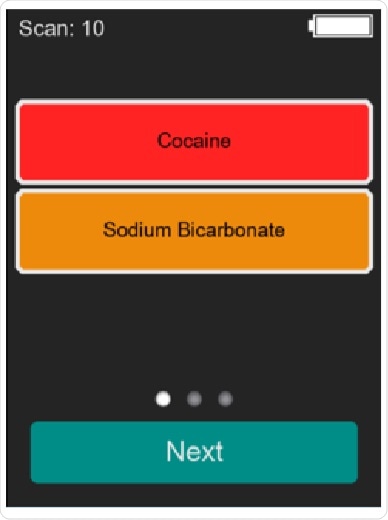
Figure 4. Color-coded Hazard Warning
About Metrohm
At Metrohm is one of the world’s most trusted manufacturers of high-precision instruments for chemical analysis. Metrohm was founded in 1943 by engineer Bertold Suhner in Herisau, Switzerland. Today, Metrohm is represented in 120 countries by subsidiaries and exclusive distributors. The global Metrohm Group also includes the Dutch companies Metrohm Applikon and Metrohm Autolab, manufacturers of online analyzers and instruments for electrochemical research, respectively. Recently, the Metrohm Group was joined by Metrohm Raman, a leading manufacturer of handheld Raman spectrometers.
Metrohm is the global market leader in analytical instruments for titration. Instruments for ion chromatography, voltammetry, conductivity, and stability measurement make the Metrohm portfolio for ion analysis complete. Instruments for Near-infrared and Raman spectroscopy are another, strongly growing segment of the Metrohm portfolio.
Metrohm is a problem solver, both in the laboratory and within the industrial process. To this end, the company offers their customers complete solutions, including dedicated analytical instrumentation as well as comprehensive application know-how. More than 30% of the company’s employees at the Metrohm international headquarters in Herisau work in R&D.
Metrohm has been owned 100% by the non-profit Metrohm Foundation since 1982. The Metrohm Foundation, which does not exert any influence on the company’s business operations, sponsors gifted students in the natural sciences, supports charitable and philanthropic purposes and, above all, ensures the independence of the company.
Sponsored Content Policy: News-Medical.net publishes articles and related content that may be derived from sources where we have existing commercial relationships, provided such content adds value to the core editorial ethos of News-Medical.Net which is to educate and inform site visitors interested in medical research, science, medical devices and treatments.